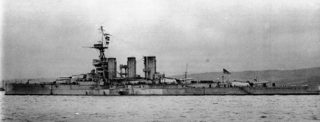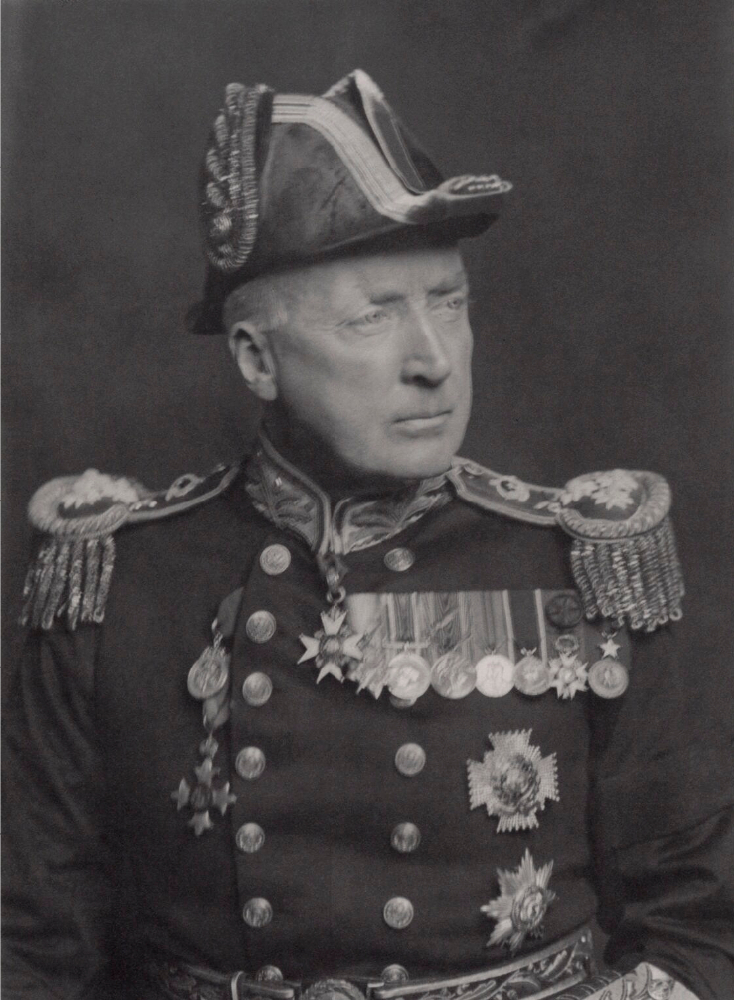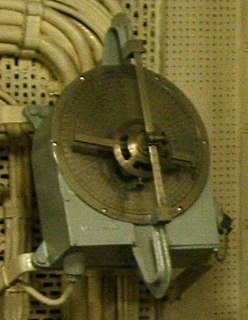Related Research Articles

HMS Queen Mary was the last battlecruiser built by the Royal Navy before the First World War. The sole member of her class, Queen Mary shared many features with the Lion-class battlecruisers, including her eight 13.5-inch (343 mm) guns. She was completed in 1913 and participated in the Battle of Heligoland Bight as part of the Grand Fleet in 1914. Like most of the modern British battlecruisers, the ship never left the North Sea during the war. As part of the 1st Battlecruiser Squadron, Queen Mary attempted to intercept a German force that bombarded the North Sea coast of England in December 1914, but was unsuccessful. The ship was refitting in early 1915 and missed the Battle of Dogger Bank in January, but participated in the largest fleet action of the war, the Battle of Jutland in mid-1916. She was hit twice by the German battlecruiser Derfflinger during the early part of the battle and her magazines exploded shortly afterwards, sinking the ship.

The Orion-class battleships were a group of four dreadnought battleships built for the Royal Navy (RN) in the early 1910s. The first 13.5-inch-gunned (343 mm) battleships built for the RN, they were much larger than the preceding British dreadnoughts and were sometimes termed "super-dreadnoughts". The sister ships spent most of their careers assigned to the 2nd Battle Squadron of the Home and Grand Fleets, sometimes serving as flagships. Aside from participating in the failed attempt to intercept the German ships that had bombarded Scarborough, Hartlepool and Whitby in late 1914, the Battle of Jutland in May 1916 and the inconclusive action of 19 August, their service during World War I generally consisted of routine patrols and training in the North Sea.

The King George V-class battleships were a group of four dreadnought battleships built for the Royal Navy (RN) in the early 1910s that were sometimes termed super-dreadnoughts. The sister ships spent most of their careers assigned to the 2nd Battle Squadron of the Home and Grand Fleets, sometimes serving as flagships. In October 1914, Audacious struck a mine and sank. Aside from participating in the failed attempt to intercept the German ships that had bombarded Scarborough, Hartlepool and Whitby in late 1914, the Battle of Jutland in May 1916 and the inconclusive action of 19 August, the surviving ships' service during the First World War generally consisted of routine patrols and training in the North Sea.

HMS Orion was the lead ship of her class of four dreadnought battleships built for the Royal Navy in the early 1910s. She spent the bulk of her career assigned to the Home and Grand Fleets, generally serving as a flagship. Aside from participating in the failed attempt to intercept the German ships that had bombarded Scarborough, Hartlepool and Whitby in late 1914, the Battle of Jutland in May 1916 and the inconclusive action of 19 August, her service during World War I generally consisted of routine patrols and training in the North Sea.

HMS Neptune was a dreadnought battleship built for the Royal Navy in the first decade of the 20th century, the sole ship of her class. She was the first British battleship to be built with superfiring guns. Shortly after her completion in 1911, she carried out trials of an experimental fire-control director and then became the flagship of the Home Fleet. Neptune became a private ship in early 1914 and was assigned to the 1st Battle Squadron.

The St Vincent-class battleships were a group of three dreadnought battleships built for the Royal Navy in the first decade of the 20th century. The sister ships spent their entire careers assigned to the Home and Grand Fleets. Aside from participating in the Battle of Jutland in May 1916 and the inconclusive action of 19 August several months later, their service during the First World War generally consisted of routine patrols and training in the North Sea. Vanguard was destroyed in 1917 by a magazine explosion with the near total loss of her crew. The remaining pair were obsolete by the end of the war in 1918, and spent their remaining time either in reserve or as training ships before being sold for scrap in the early 1920s.

The Bellerophon-class battleship was a group of three dreadnought battleships that were built for the Royal Navy in the first decade of the 20th century. The sister ships spent most of their careers assigned to the Home and Grand Fleets. Aside from participating in the Battle of Jutland in May 1916, and the inconclusive action of 19 August several months later, their service during the First World War generally consisted of routine patrols and training in the North Sea.

HMS Dreadnought was a Royal Navy battleship whose design revolutionised naval power. The ship's entry into service in 1906 represented such an advance in naval technology that her name came to be associated with an entire generation of battleships, the "dreadnoughts", as well as the class of ships named after her. Likewise, the generation of ships she made obsolete became known as "pre-dreadnoughts". Admiral Sir John "Jacky" Fisher, First Sea Lord of the Board of Admiralty, is credited as the father of Dreadnought. Shortly after he assumed office, he ordered design studies for a battleship armed solely with 12 in (305 mm) guns and a speed of 21 knots. He convened a "Committee on Designs" to evaluate the alternative designs and to assist in the detailed design work.

The Colossus-class battleships were a pair of dreadnought battleships built for the Royal Navy (RN) at the end of the first decade of the 20th century, the last 12-inch-gunned (305 mm) battleships built for the RN. The sister ships spent their whole careers assigned to the Home and Grand Fleets, often serving as flagships. Aside from participating in the Battle of Jutland in May 1916, and the inconclusive action of 19 August several months later, their service during the First World War generally consisted of routine patrols and training in the North Sea.

HMS Tiger was a battlecruiser of the Royal Navy and the eleventh ship to bear that name. She was built by John Brown and Company of Clydebank, Scotland, and launched in 1913. Tiger was the most heavily armoured battlecruiser of the Royal Navy at the start of the First World War, but was not yet ready for service. The ship was assigned to the 1st Battlecruiser Squadron for the duration of the war and participated in the Battle of Dogger Bank in early 1915, though she was still shaking down and did not perform well. Tiger next participated in the Battle of Jutland in 1916, where she was only lightly damaged despite suffering many hits by German shells. Apart from providing distant cover during the Second Battle of Heligoland Bight in 1917, she spent the rest of the war on uneventful patrols in the North Sea.

A fire-control system is a number of components working together, usually a gun data computer, a director, and radar, which is designed to assist a ranged weapon system in targeting, tracking and hitting its target. It performs the same task as a human gunner firing a weapon, but attempts to do so faster and more accurately.

Admiral Sir Frederic Charles Dreyer, was an officer of the Royal Navy. A gunnery expert, he developed a fire control system for British warships, and served as flag captain to Admiral Sir John Jellicoe at the Battle of Jutland. He retired with the rank of admiral in 1943, having served through two world wars and having already retired once.

Pitometer logs are devices used to measure a ship's speed relative to the water. They are used on both surface ships and submarines. Data from the pitometer log is usually fed directly into the ship's navigation system.

Rangekeepers were electromechanical fire control computers used primarily during the early part of the 20th century. They were sophisticated analog computers whose development reached its zenith following World War II, specifically the Computer Mk 47 in the Mk 68 Gun Fire Control system. During World War II, rangekeepers directed gunfire on land, sea, and in the air. While rangekeepers were widely deployed, the most sophisticated rangekeepers were mounted on warships to direct the fire of long-range guns.
In naval gunnery, when long-range guns became available, an enemy ship would move some distance after the shells were fired. It became necessary to figure out where the enemy ship, the target, was going to be when the shells arrived. The process of keeping track of where the ship was likely to be was called rangekeeping, because the distance to the target—the range—was a very important factor in aiming the guns accurately. As time passed, train, the direction to the target, also became part of rangekeeping, but tradition kept the term alive.

The dreadnought was the predominant type of battleship in the early 20th century. The first of the kind, the Royal Navy's HMS Dreadnought, had such an impact when launched in 1906 that similar battleships built after her were referred to as "dreadnoughts", and earlier battleships became known as pre-dreadnoughts. Her design had two revolutionary features: an "all-big-gun" armament scheme, with an unprecedented number of heavy-calibre guns, and steam turbine propulsion. As dreadnoughts became a crucial symbol of national power, the arrival of these new warships renewed the naval arms race between the United Kingdom and Germany. Dreadnought races sprang up around the world, including in South America, lasting up to the beginning of World War I. Successive designs increased rapidly in size and made use of improvements in armament, armour and propulsion throughout the dreadnought era. Within five years, new battleships outclassed Dreadnought herself. These more powerful vessels were known as "super-dreadnoughts". Most of the original dreadnoughts were scrapped after the end of World War I under the terms of the Washington Naval Treaty, but many of the newer super-dreadnoughts continued serving throughout World War II.
Arthur Joseph Hungerford Pollen was an English journalist, businessman, and commentator on naval affairs who devised a new computerised fire-control system for use on battleships prior to the First World War. His most important technical innovation was one of the world's first electrically-powered analogue computers, patented as the Argo Clock: a differential analyser which enabled big guns to engage with long-range targets when both ships were moving at speed in different directions.

The Dumaresq is a mechanical calculating device invented around 1902 by Lieutenant John Dumaresq of the Royal Navy. It is an analogue computer that relates vital variables of the fire control problem to the movement of one's own ship and that of a target ship.

The Vickers Range Clock was a clockwork device used by the Royal Navy for continuously calculating the range to an enemy ship.
Gyro rate unit refers to a fire-control computer developed by the Royal Navy of the United Kingdom in 1937, and which was used extensively on British warships in World War II. In the 1930s the Royal Navy began to investigate the possibility of combining gyroscopes with optical sights to directly and accurately measure target aircraft speed and direction and began development of the GRU in 1937.A gyroscope was attached, via mechanical linkage, to an optical monocular sight to form the gyro rate unit or GRU.
References
Citations
- ↑ Brooks 2001, p. 70.
- ↑ Brooks 2001, p. 71.
- ↑ Brooks 2001, p. 109.
- ↑ Submarine Plotting Tables (Technical report). Royal Navy Submarine Museum. 1977.
- ↑ Brooks, John (2005). Dreadnought Gunnery and the Battle of Jutland: The Question of Fire Control. Routlage. p. 155.
- ↑ Cooper 1930, p. 994.
- ↑ Brooks 2001, p. 158.
Bibliography
- Cooper, F. G. (8 August 1930). "Aids to Navigation: Lecture III". Journal of the Royal Society of Arts. 78 (1055): 990–1001. JSTOR 41358564.
- Brooks, John (2001). Fire control for British Dreadnoughts : choices of technology and supply (PDF) (Technical report). Department Of War Studies, King's College, London.